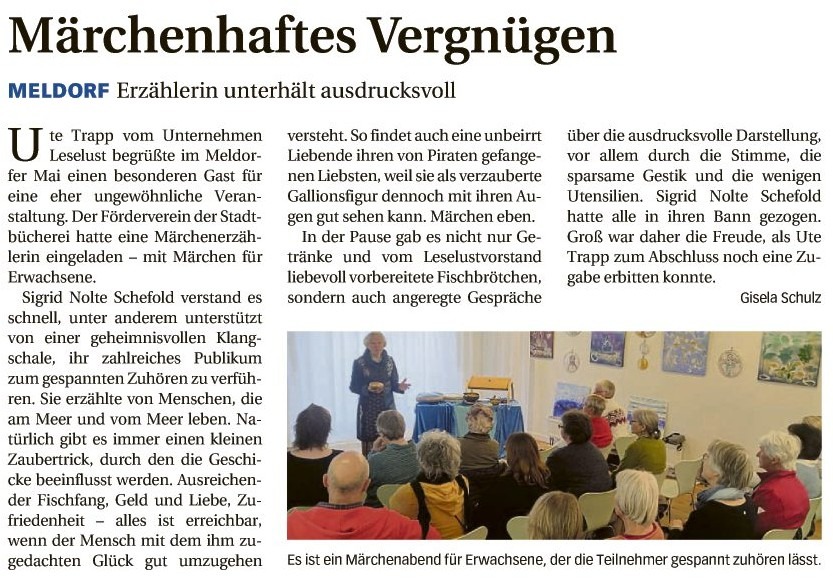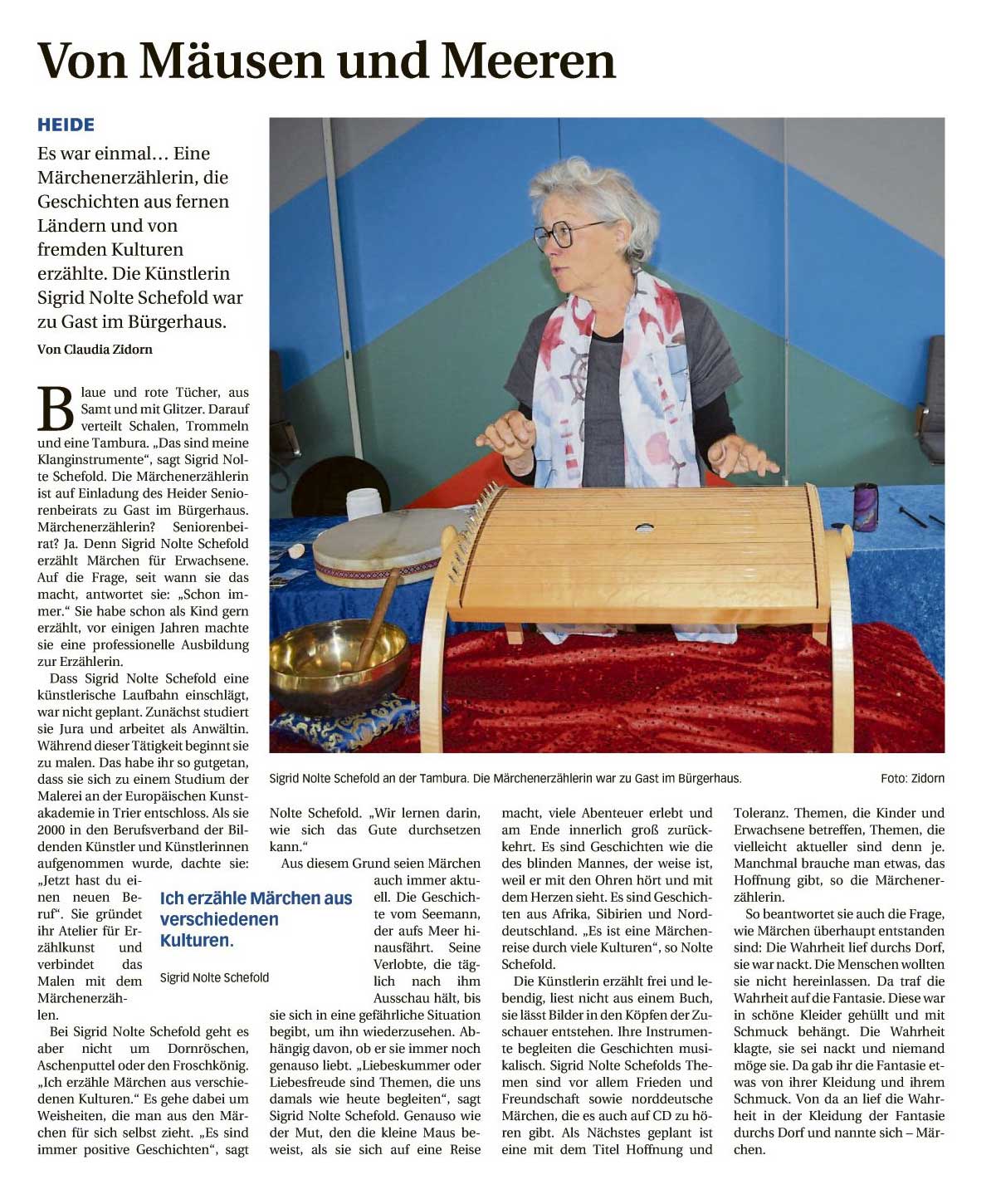
Archive: FAQs
Weltgeschichtentag 2023 auf OK Westküste FM
Hörbeitrag zum Weltgeschichtentag vom 20. März 2023 auf OK Westküste FM. Sigrid Nolte Schefold erzählt drei Norddeutsche Märchen zum Thema „Gemeinsam gestalten” am Weltvorlesetag—hören Sie mal rein
Aufnahme vom 20. März 2023 OK Westküste FM
Sigrid Nolte Schefold stellt ihre neue CD vor
Märchen von Frieden und Freundschaft ist der Titel der neuen CD von Sigrid Nolte Schefold. Mit der CD stellt sie Märchen aus den unterschiedlichsten Kulturen vor: Von China bis zur Ukraine, von Nordamerika bis nach Tibet.
Sigrid Nolte Schefold stellt ihre neue Märchen-CD vor
OK Westküste FM – Freizeit – Märchenzeit mit Sigrid Nolte Schefold
Märchen zu erzählen ist ihr Steckenpferd und das hat sie sogar professionell erlernt. Sigrid Nolte Schefold betreibt ein Atelier für Erzählkunst und tritt als Märchenerzählerin auf, sagt Christian Nicolay anläßlich seines Interviews mit Sigrid Nolte Schefold.
Dagmar Klein, Kunsthistorikerin, Gießen, 2004
„Für Sigrid Nolte Schefold ist das Zeichnen und Malen gleichermaßen wichtig. Sie geht auch bei ihren komplett aus der Farbe gestalteten Bildern, auf denen keine Linie zu erkennen ist, von Skizzen der Natur aus, die im Malprozeß mit der Erinnerung verfließen. Nicht Nachahmung ist ihr Ding, sondern Gestaltung des Gesehenen, Gefühlten und Erlebten.”
Dagmar Klein, Kunsthistorikerin, Gießen, 2004
Annegret Zander, Pastorin, 2004
„Trauernde auf ihrem Weg begleiten”
Seminar im evangelischen Gemeindebildungszentrum Bad Orb, „Existenzielle Fragen und Gefühle erforscht und bearbeitet sie auf kraftvolle Weise. Sie mutet uns auch einiges zu: eine Auseinandersetzung mit der Lebensfülle.”
Annegret Zander, Pastorin, 2004
Dr. Sabine Jung, Kunsthistorikerin, Arbeitskreis Selbständiger Kulturinstitute e.V., Bonn, 2002
Sigrid Nolte Schefold lebt sich aus: vom Format her, in der Wucht der Farben, in der Vehemenz des Farbauftrags, im Tempo der Arbeit. Als Betrachter nimmt uns zunächst ihre Farbgebung ein. Farbe als Gefühlsträger, als Bildthema: im koloristischen, luminaristischen und chromatischen Prinzip, in Eigenlicht und Bildlicht, in Beleuchtungslicht. All das ist wesentliche Grundlage der Malerei des 20. und 21. Jahrhunderts. Wir fühlen uns erinnert an den abstrakten Expressionismus, die amerikanische Avantgarde.”
Dr. Sabine Jung, Kunsthistorikerin, Arbeitskreis Selbständiger Kulturinstitute e.V., Bonn, 2002
Statement from Dr. Julia Nolte »True Love«
True Love
When Sigrid Nolte Schefold paints she paints a river of colors, stream of lines and shapes. Layers over layers. What turns out is a vivid image of her spirit – dynamic and diverse. It is because of this diversity that her paintings can hardly be defined. One thing all of Sigrid Nolte Schefold’s paintings share, though, is their overdimensional size and the flow of the paint brush that bore them.
Sigrid Nolte Schefold herself has a quite unconventional standpoint regarding the composition of art. “You can start your painting out one way, then turn it around and finally finish it standing upside down”, she says. It becomes clear that her paintings must belong to the category “abstract”, where objects and human faces turn into non-realistic images. Many of them can also be considered “concrete”, meaning, that only concrete dimension lies in the painting; it has no equivalent in the real world of images. Sigrid Nolte Schefold’s paintings live by colors rather than motives. And her favorite color is red …
Observing Sigrid Nolte Schefold paint is both wonderful and frightening. Wonderful because she throws away her lawyer’s clothes and puts on white overalls sprinkled with colors. Wonderful because she works with unhindered determination and shiny eyes. It is when inspiration does not tell her where to move the paint brush that watching Sigrid Nolte Schefold paint becomes frightening. She gets hectic. Desperate about the objective to improve but not to destroy.
Painting is walking on the ridge. Trusting yourself to mix the right color, chose the right paint brush. Make the right move. Only there is no “right” in creativity and that makes it even harder. It’s not about choosing a color that would match the living room couch. It’s about painting what you like. And painting what you not like. It’s about letting it all out. It’s “True Love” when Sigrid Nolte Schefold paints.
Dr. Julia Nolte
Dr. Kirsten Kretschmann-Muche, Kunsthistorikerin, Frankfurt a.M., 2000
Tupfend, springend, zeichnerisch grazil und mit viel überlegter Energie führt Sigrid Nolte Schefold den Pinsel. Rhythmus und Phantasie zeichnen ihre atmosphärisch dichten Farbräume aus. Mal sind die Kompositionen dicht, mal kommt ein haptischer Moment in Form von zusammengenähten schmalen Stoffbahnen dazu. Hitze und Glut scheinen einem entgegenzuschlagen. Von großer Leichtigkeit, fast wie spielerisch hingehaucht, wirken ihre neuesten Werke. Wo befindet sich die versprochene Märchenwelt?”
Dr. Kirsten Kretschmann-Muche, Kunsthistorikerin, Frankfurt a.M., 2000
Artikel Die Dithmarscher Landeszeitung August 2022
Artikel in der DLZ »Die Dithmarscher Landeszeitung« Tageszeitung Heide.

Artikel von Claudia Zidorn



